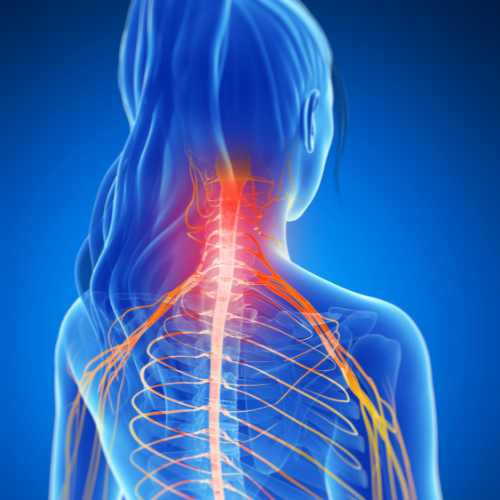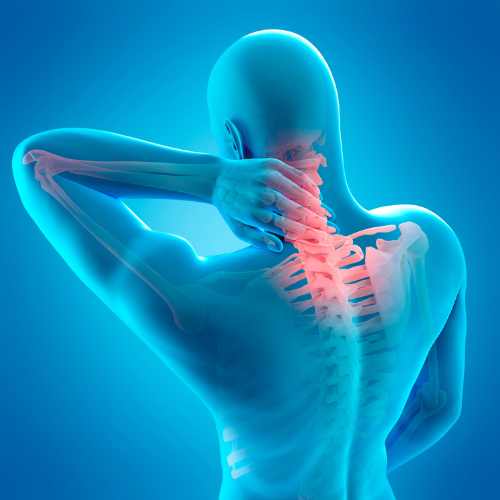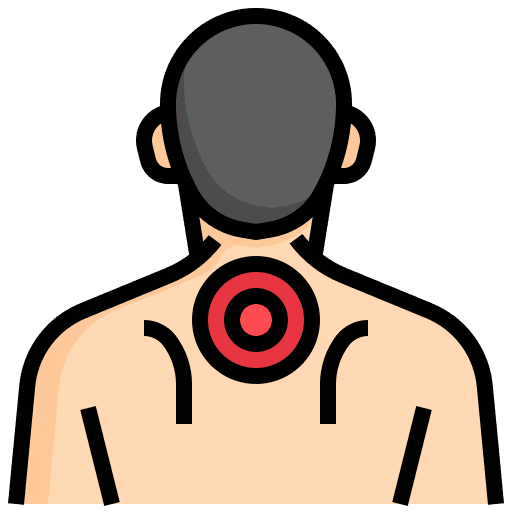Neck Pain Treatment
Neck Pain Treatment for Relieve

Injury: Whiplash, falls, sports injuries, or any other type of trauma can cause damage to the neck muscles or ligaments.
Degenerative Disc Disease: Wear and tear on the discs between the vertebrae can cause them to break down and put pressure on nerves root in the neck.
Arthritis: Osteoarthritis, rheumatoid arthritis, or other forms of arthritis can cause inflammation and pain in the neck joints.
Pinched Nerves: A pinched nerve in the neck can cause pain, tingling, or numbness in the neck and down the arms.
Muscle Strain: Overuse of the neck muscles or sudden movements can cause strain and pain.
Tumors: Rarely, tumors in the neck can cause pain and discomfort.
Infections: Infections like meningitis or abscesses in the neck can cause pain and stiffness.
Diagnosing of Neck Pain Treatment
Medical History:
The doctor will ask about the patient's medical history and physical exam, including any previous injuries or surgeries.
Physical Examination:
The doctor will conduct a physical examination, checking the patient's neck for pain, swelling, tenderness, and any limitations in range of motion.
Imaging Tests:
X-rays, CT scans, MRI, and ultrasounds can help to identify any abnormalities or injuries to the neck.
Nerve Conduction Tests:
These tests can evaluate the function of nerves in the neck and determine if there is a pinched nerve.
Blood Tests:
Blood tests may be ordered to check for underlying medical conditions that could be causing neck pain.


Ask About Medical History:
The doctor will ask about any previous injuries, surgeries, or medical conditions that could be related to neck pain.
Evaluate Posture and Movement:
The doctor will observe the patient's posture and range of motion in the arms, shoulders, neck and back.
Palpate the Neck:
The doctor will use their hands to feel for tenderness, swelling, and any abnormalities in the neck muscles or space between the vertebrae.
Check Reflexes and Sensations:
The doctor may check for any changes in reflexes or sensations in the arms, hands, or fingers, which could be a sign of nerve damage.
Perform neck pain and Neurological symptoms Exams:
The doctor may conduct tests to evaluate the function of the nervous system, such as checking muscle strength and reflexes.
Neck Pain Treatment Options

Neck pain treatment physiotherapy is a common non-surgical treatment option for neck pain. It involves using physical techniques to manage and alleviate pain. Physiotherapy can help alleviate pain on the right side of the neck. Some physiotherapy treatment for neck pain options in Vision Physiotherapy Center in Banani include:
Manual Therapy:
This involves hands-on techniques, such as massage or mobilization, to help relieve tension and ease pain in the neck.
Exercise Therapy:
This includes stretching and strengthening exercises to help improve the range of motion and build strength in the neck muscles.
Pulsed Electromagnetic Field Therapy (PEMF):
It is a type of therapy that uses electromagnetic fields to improve the health and functioning of cells in the body.
Electrical Stimulation:
This involves using electrical impulses to stimulate the nerves in the neck and reduce pain.
Ultrasound Therapy:
This involves using sound waves to penetrate deep into the muscles and tissues of the neck to relieve pain and promote healing.
Acupuncture:
Acupuncture is a form of alternative medicine that involves inserting thin needles into specific points on the body. It is commonly used to treat muscle pain and a variety of other conditions.
Heat and Cold Therapy:
Alternating heat and cold can help to reduce inflammation and ease muscle tension.
Posture Correction:
Poor posture can contribute to neck pain, so correcting posture can help alleviate the pain.
Traction:
Traction is a type of stretching that can help to relieve pressure on the neck vertebrae and reduce pain.
Physiotherapists at Vision Physiotherapy Center in Uttara can help design a treatment plan tailored to the individual’s needs, which may involve a combination of these techniques. Physiotherapy can be an effective non-surgical option for managing neck pain, and it can also help prevent future episodes of pain.
Heat and Cold Therapy
Heat and cold therapy are two common physiotherapy treatment options for managing neck pain that is provided by Vision Physiotherapy Center Dhaka. Heat therapy, also known as thermotherapy, involves the application of warmth to the affected area. Cold therapy, also known as cryotherapy, involves the application of cold to the affected area.


Acupuncture
PEMF

Electrotherapy:
Muscle Release Technique (MRT)
In addition to pressure, the therapist may also use stretching techniques to further release tension in the muscles. This can involve gentle stretching or more active techniques, such as having the patient actively move their head and neck while the therapist provides resistance.
Some Help - Full Tips that Reduce Neck Pain

Maintain Good Posture:
Sitting and standing with proper posture can help reduce the strain your neck muscles and joints. Keep the shoulders relaxed, the chin slightly tucked in, and the ears aligned with the shoulders.
Take Breaks:
If sitting at a desk or using a computer for long periods, take regular breaks to stretch and move around. This can help reduce muscle tension and improve circulation.
Use a Supportive Pillow:
Choosing a pillow that supports the neck and allows for proper alignment of the spinal canal can help reduce neck pain and stiffness.
Practice Relaxation Techniques:
Stress can contribute to muscle tension and neck pain, so practicing relaxation techniques, such as deep breathing exercises, meditation, or yoga, can help alleviate pain and promote overall wellness.
Stay Active:
Regular exercises, such as walking, swimming, or cycling, and pain relief medications can help improve muscle strength as well as flexibility, which can help reduce the risk of neck pain and improve overall health.
It’s important to get advice from your doctor or a healthcare provider in Bangladesh before starting any new neck exercises or relaxation routine, particularly if experiencing neck pain. They can help determine the best course of action and provide guidance on how to safely and effectively manage neck pain at home.
